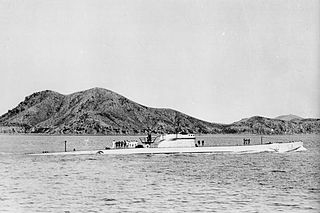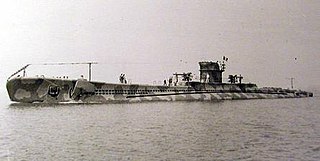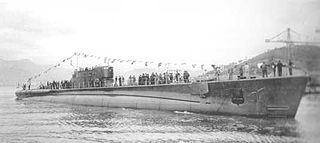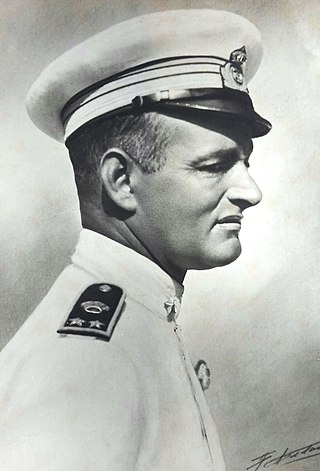
The Regia Marina (RM) or Royal Italian Navy was a navy of the Kingdom of Italy from 1861 to 1946. In 1946, with the birth of the Italian Republic, the Regia Marina changed its name to Marina Militare.

Barbarigo was a World War II Italian Marcello-class submarine. It was built by the Cantieri Riuniti dell'Adriatico, and was commissioned on 19 September 1938.

The Marcello class was a class of nine submarines built in 1937 and 1938 by CRDA in Trieste for the Royal Italian Navy. Two similar submarines built in 1939 at La Spezia by Oto Melara are sometimes considered part of the class. All eleven served in the Mediterranean Sea at the start of the Second World War. After Provana's 1940 sinking, the remaining boats were transferred to the BETASOM Atlantic submarine base at Bordeaux in August 1940. After four boats had been sunk in the Atlantic, Barbarigo and Comandante Cappellini were then selected for conversion to "transport submarines" in order to exchange rare or irreplaceable trade goods with Japan. Cargo capacity of 160 tons reduced reserve buoyancy from 20–25% to 3.5–6%; and armament was reduced to defensive machine guns. Only Dandolo was in operational condition at the end of the war.

The Marconi class was a class of six submarines built for the Royal Italian Navy. The submarines were all launched between 1939 and 1940, and all but one, Luigi Torelli, were lost in the Atlantic during the Second World War.
Brin was a Brin-class submarine built for and operated by Italy's Regia Marina during World War II.

BETASOM was a submarine base established at Bordeaux, France by the Regia Marina during the Second World War. From this base, Italian submarines participated in the Battle of the Atlantic from 1940 to 1943 as part of the Axis anti-shipping campaign against the Allies.

The Cagni or Ammiraglio Cagni class was a class of submarines built for Italy's Regia Marina during World War II.

Leonardo da Vinci was a Marconi-class submarine of the Italian navy during World War II. It operated in the Atlantic from September 1940 until its loss in May 1943, and became the top scoring non-German submarine of the entire war.
The Italian submarine fleet of World War II was the largest in the world at the time, with 116 submarines. It saw action during the Second World War, serving mainly in the Mediterranean. During the conflict 88 submarines, 75% of its total strength, were lost.

The Calvi class was a class of three submarines built by Oderno-Terni-Orlando in Genoa for the Royal Italian Navy. The submarines were built in 1935, and all three served in the Mediterranean at the start of the Second World War. The boats were transferred to the BETASOM Atlantic submarine base at Bordeaux in August 1940. In December 1941 the boats were used for a rescue mission of 254 sailors from the sunken German auxiliary cruiser Atlantis. After Calvi had been sunk, Finzi and Tazzoli were selected for conversion to "transport submarines" in order to exchange rare or irreplaceable trade goods with Japan. Cargo capacity of 160 tons reduced reserve buoyancy from 20–25% to 3.5–6%; and armament was reduced to defensive machine guns.
Pietro Micca was an Italian submarine which served with the Regia Marina in World War II. She was the third ship named after Pietro Micca, the Savoyard soldier who became a national hero for his sacrifice in the defence of Turin against the French troops in 1706. This boat was the prototype for a class of fast, long range submarines with conventional torpedo armament, naval mine laying capability, and useful secret transport capacity. The ship was built at the Tosi shipyard in Taranto. She was laid down on 15 October 1931 and launched on 31 March 1935. The boat fully met design requirements, but was too expensive to be repeated.
Archimede was a Brin-class submarine built for the Royal Italian Navy during the 1930s.

The Argo-class was a class of two coastal submarines built by Cantieri Riuniti dell'Adriatico in Monfalcone for Portugal but operated by the Royal Italian Navy after Portugal was unable to pay construction costs. The submarines were built in 1936, and both served in the Mediterranean Sea at the start of the Second World War. The boats were transferred to the BETASOM Atlantic submarine base at Bordeaux in 1940, but returned to the Mediterranean in 1941, where both were sunk within a few days of the September 1943 Italian armistice.
Giuseppe Finzi was one of three Calvi-class submarines built for the Regia Marina during the 1930s. Completed in 1936, she played a minor role in the Spanish Civil War of 1936–1939 supporting the Spanish Nationalists. The submarine made multiple patrols in the Atlantic Ocean during the Second World War, sinking five Allied ships. Gisueppe Finzi began conversion into a transport submarine in 1943, but was captured by the Germans in September 1943 before it was completed and redesignated as UIT-21. She was scuttled by them in August 1944 to prevent her capture.
Pietro Calvi was the lead ship of its class of two submarines built for the Regia Marina during the 1930s. Completed in 1936, she played a minor role in the Spanish Civil War of 1936–1939 supporting the Spanish Nationalists. The submarine made multiple patrols in the Atlantic Ocean during the Second World War, sinking seven Allied ships. Pietro Calvi was rammed and sunk by a British convoy escort in July 1942.
Michele Bianchi was a Marconi-class submarine of the Italian Regia Marina that saw action in the Second World War. The submarine,, was launched on 3 December 1939.
Guglielmotti was a Brin-class submarine built for the Royal Italian Navy during the 1930s.

Enrico Tazzoli was one of three Calvi-class submarines built for the Regia Marina during the 1930s. Completed in 1936, she played a minor role in the Spanish Civil War of 1936–1939 supporting the Spanish Nationalists. She operated in the Atlantic during the Second World War and was second only to the submarine Leonardo da Vinci as the highest scoring Italian submarine of the conflict. Enrico Tazzoli was converted in 1943 to be a submarine transport for blockade-running between Europe and the Far East. She was lost on her first voyage in this role. She had been pronounced missing on 17 May after loss of contact. Her loss has never been definitively explained.

Salvatore Bruno Todaro was an Italian naval officer and submariner during World War II. He is best known for his participation in the battle of the Atlantic and the two instances in which he towed to safety the lifeboats carrying the survivors of ships he had sunk.

Primo Longobardo was an Italian naval officer and submariner during World War II.











